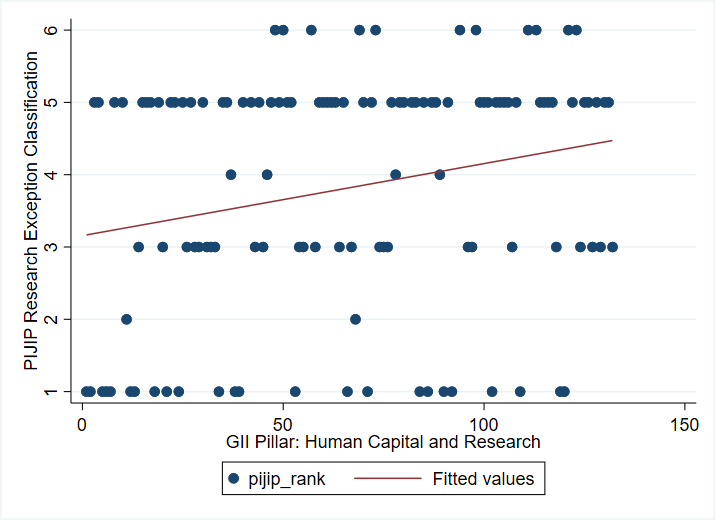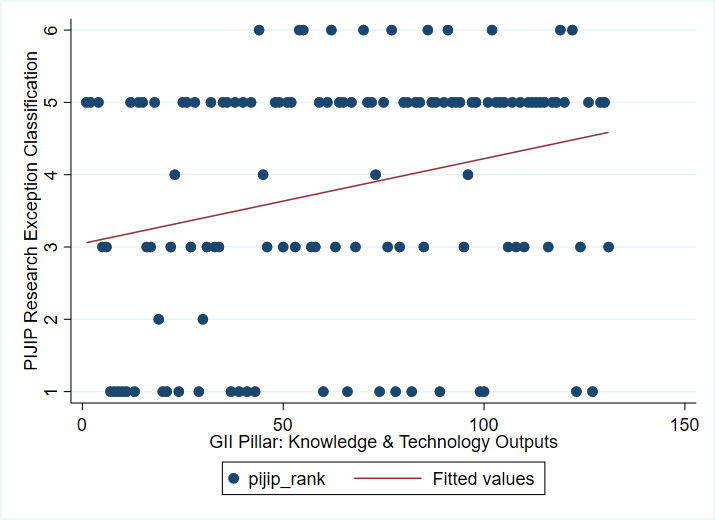Michael Palmedo
This post describes the newly released Global Innovation Index and PIJIP’s ongoing research into copyright exceptions for research. It then presents correlations between subsets of the Global Innovation Index data and PIJIP’s categorization of copyright laws.
The Global Innovation Index
Last week, WIPO launched the 2022 Global Innovation Index (GII), which ranks 132 countries according to 81 indicators related to innovation. It finds that global R&D has continued to boom, but that productivity growth has stagnated. But beneath the top line findings is a lot of interesting data on innovation inputs and outputs.
The 81 indicators are grouped into seven broad “pillars”. These are Institutions; Human capital and research; Infrastructure; Market sophistication; Business sophistication; Knowledge and Technology outputs; and Creative outputs.
PIJIP’s Classification of Copyright Exceptions for TDM Research
For the last few years, PIJIP has been analyzing the copyright exceptions for researchers in the copyright law of each WIPO Member state. Specifically, we have reviewed the laws of over 200 countries to see the degree to which they “have a research exception in their law that is sufficiently open to be able to permit reproduction and communications of copyrighted work needed for academic text and data mining (TDM) research.”
In Research Exceptions in Comparative Copyright, by Flynn et. al. (2022) we use this six-point scale to classify the exceptions’ openness:
- Exception is fully open to all uses, works, users. Importantly, it allows researchers to both reproduce works and share their reproductions within teams of researchers;
- Exception allows reproduction (not other uses) of all works by all users;
- Exception allows private reproduction or use by individual users;
- Exception allows institutional uses (i.e. – libraries);
- Exception contains restrictions on types of works subject to exception;
- Exception allows the use of excerpts only (no legal Text and Data Mining possible)
The paper linked above describes this classification in more detail.
How PIJIP’s Classification Relates to the GII Rankings
If the strength of copyright exceptions for researchers is associated with other innovative inputs and outputs, then we should be able to see correlations between PIJIP’s classification of countries’ laws, and some of the pillars found in the GII.
The GII pillar “Human Capital and Research” is a grouped average of the following indicators that measure innovative inputs:
- Expenditure on education, as a percentage of GDP
- Government funding/pupil, secondary, as a percentage of GDP per capita
- School life expectancy, in years
- PISA scales in reading, math and science
- Pupil-teacher ratio, secondary school
- Tertiary enrolment
- Percentage of graduates in science and engineering
- Tertiary inbound mobility
- Researchers: Full time employees per million of population
- Gross expenditure on R&D, as a percentage of GDP
- Global corporate R&D investors, top 3, in millions of U.S. dollars USD
- QS university ranking, top 3
The GII ranks countries according to this pillar on pages 50-5 of the report, with Korea ranked #1. Figure 1 shows the positive correlation between the ranking of countries by this pillar, and PIJIP’s classification of countries’ research exceptions. This positive correlation implies that countries with a stronger focus on education and more researchers tend to have copyright exceptions with a greater degree of openness.

The GII pillar “Knowledge and Technology Outputs” is a grouped average of the following indicators measuring outputs of innovative processes:
- Patents by origin per billion U.S. dollars of GDP
- PCT patents by origin per billion U.S. dollars of GDP
- Utility models by origin per billion U.S. dollars of GDP
- Scientific and technical articles per billion U.S. dollars of GDP
- Citable documents: H-index
- Labor productivity growth
- New businesses per thousands of population aged 15-64
- Software spending as a percentage of GDP
- ISO 9001 quality certificates per billion U.S. dollars of GDP
- High-tech manufacturing as a percentage of total manufacturing
- Intellectual property receipts as a percentage of total trade
- Production and export complexity
- High-tech exports as a percentage of total trade
- ICT services exports as a percentage of total trade
Switzerland is the top-ranked country for this measurement of Knowledge and Technology Outputs. As shown by Figure 2, PIJIP’s categorization of countries’ copyright exceptions for research is positively correlated with the GII rankings for this pillar. The association implies that countries with stronger copyright exceptions for researchers produce a more innovative output (relative to total output) than countries with weaker exceptions.

Together, these correlations show that the way research exceptions are crafted is associated with real-world variables related to innovation.
As we further develop this line of research, we plan to use the data in a series of empirical experiments. We are currently working with law students to track changes in countries’ copyright exceptions over time in order to produce studies that are more detailed, and more able to find causal relationships.




